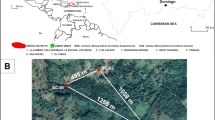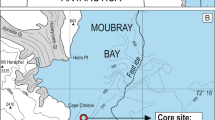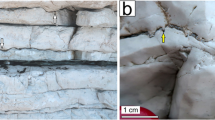Abstract
LEG 40 of the Deep Sea Drilling Project (DSDP) drilled two holes in the Angola Basin: site 364 and site 365 (Fig. 1). Native copper was found in two samples (364-5-2, 19–21 cm and 364-5-2, 22-24 cm) from one of the cores taken at site 364. The botryoidal form of most of the copper grains initially suggested formation in situ and the subsequent discovery of copper casts of planktonic foraminifera removed any lingering thoughts of contamination. This is not the first report of native copper in DSDP cores. Most other occurrences have, however, been found in basement rocks (for example, site 282) or in the sediments immediately overlying basement rocks (site 105), whence the copper was presumably derived. The copper reported here occurs at least 3 km above volcanic basement rocks, and no copper has yet been found in samples above or below it. Only at site 149 (Venezuelan Basin) has copper previously been found in non-basement-associated sediments. There it occurs as “a number of very small metallic incrustations” in one core of pelagic clay1.
This is a preview of subscription content, access via your institution
Access options
Subscribe to this journal
Receive 51 print issues and online access
$199.00 per year
only $3.90 per issue
Buy this article
- Purchase on Springer Link
- Instant access to full article PDF
Prices may be subject to local taxes which are calculated during checkout
Similar content being viewed by others
References
Donnelly, T. W., and Nalli, G., in Init. Rep. Deep Sea Drilling Project, XV (US Government Printing Office, Washington, 1973).
Lindgren, W., Mineral Deposits, 930 (McGraw-Hill, New York, 1933).
White, D. E., Econ. Geol., 63, 301–335 (1968).
Brongersma-Sanders, M., Geol. Rdsch., 55, 365–375 (1965).
Brongersma-Sanders, M., Miner. Deposita, 3, 286–291 (1968).
Brongersma-Sanders, M., in Sedimentary Ores: Ancient and Modern, 61–71 (University of Leicester Press, 1969).
Siesser, W. G., in Init. Rep. Deep Sea Drilling Project, XL (US Government Printing Office, Washington, in the press).
Corliss, J. B., J. geophys. Res., 76, 8128–8138 (1971).
Baker, P. E., in The Ocean Basins and Margins: The South Atlantic, 493–533 (Plenum, New York, 1973).
Shannon, L. V., Fish. Bull. S. Afr., 6, 27–33 (1970).
Hay, W. W., in Studies in Paleo-Oceanography, 1–5 (SEPM Spec. Pub. 20, Tulsa, 1974).
Lovering, T. S., U. S. geol Surv. Bull., 795, 45–52 (1927).
Forrester, J. D., Econ. Geol., 37, 126–135 (1942).
Eckel, E. B., U. S. geol. Surv. Prof. Paper 219 (1949).
Siesser, W. G., Conf. Marine and Freshwater Res. S. Afr., Fiche 6 E7-G2 (1976).
Emery, K. O., Uchupi, E., Phillips, J., Bowin, C., and Mascle, J., Woods Hole Oceanog. Inst. Techn. Rep. WHOI-74-99, Unpub. Ms., 152p (1974).
Author information
Authors and Affiliations
Rights and permissions
About this article
Cite this article
SIESSER, W. Native copper in DSDP sediment cores from the Angola Basin. Nature 263, 308–309 (1976). https://doi.org/10.1038/263308a0
Received:
Accepted:
Issue Date:
DOI: https://doi.org/10.1038/263308a0
This article is cited by
-
Primary platinum-bearing copper from the Lesnaya Varaka ultramafic alkaline complex, Kola Peninsula, northwestern Russia
Mineralogy and Petrology (1998)
Comments
By submitting a comment you agree to abide by our Terms and Community Guidelines. If you find something abusive or that does not comply with our terms or guidelines please flag it as inappropriate.



